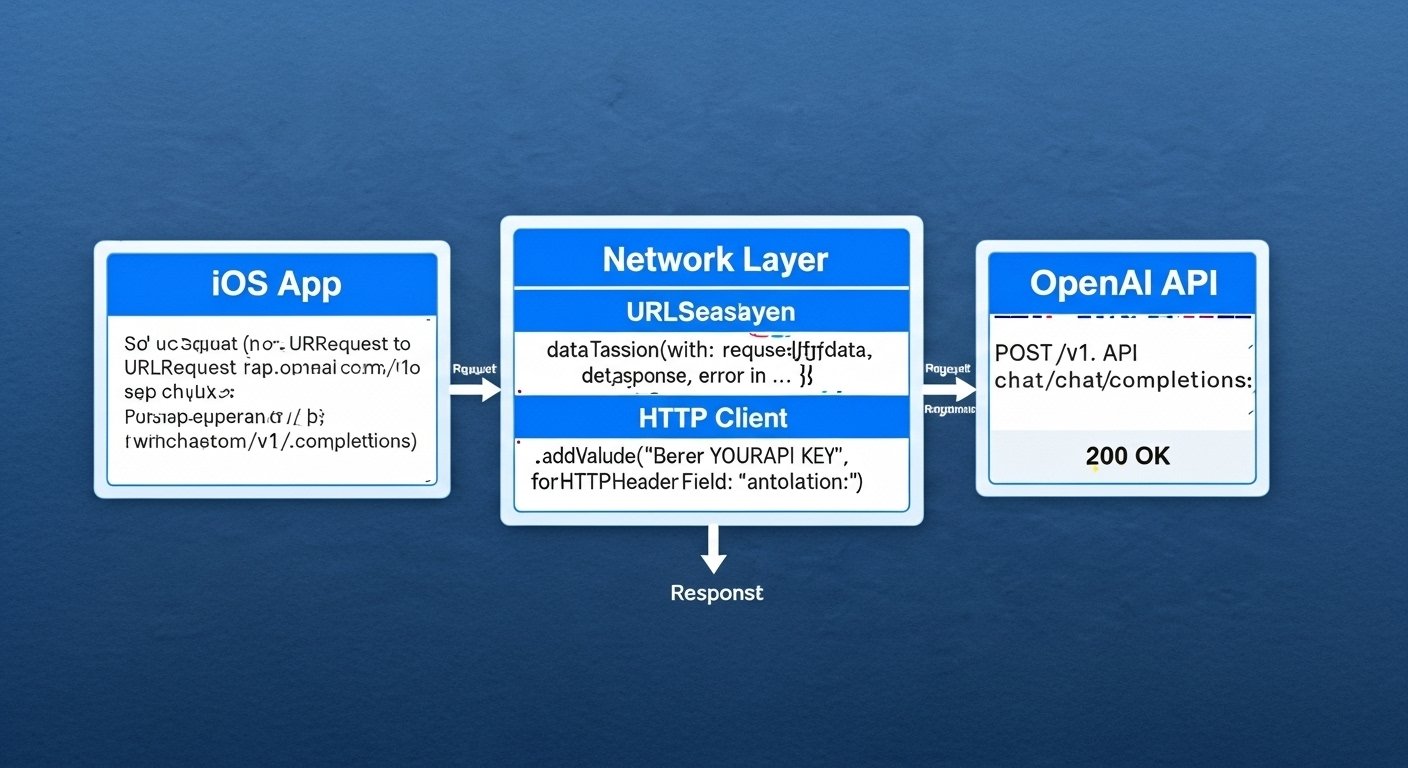The integration of artificial intelligence into mobile applications has become a game-changer for iOS developers worldwide. With OpenAI’s powerful APIs leading the charge, learning how to integrate AI OpenAI key to app in Xcode has become essential for creating next-generation applications. Whether you’re building a smart chatbot, content generation tool, or AI-powered assistant, this comprehensive guide will walk you through the entire process while maintaining the highest security standards.
The demand for AI-powered mobile applications has skyrocketed, with over 2.1 million developers actively building on the OpenAI platform as of 2024, and daily API calls surpassing 2.2 billion. This explosive growth demonstrates the critical importance of mastering OpenAI integration for modern iOS development.
Understanding OpenAI API Integration in iOS Development
When you integrate AI OpenAI key to app in Xcode, you’re essentially connecting your iOS application to one of the world’s most advanced AI platforms. OpenAI’s API provides access to powerful language models like GPT-4, image generation capabilities through DALL-E, and various other AI services that can transform your app’s functionality.
The integration process involves several key components: secure API key management, network communication setup, request/response handling, and user interface implementation. Each of these elements requires careful consideration to ensure both functionality and security.
The Current State of AI Mobile Development
The mobile AI landscape has evolved dramatically, with OpenAI leading the charge. Recent statistics show that OpenAI attracted 1.7 billion visitors in a single month, highlighting the platform’s massive adoption rate. For iOS developers, this presents an enormous opportunity to create applications that leverage cutting-edge AI capabilities.
Security-First Approach to API Key Integration
The most critical aspect of integrating AI OpenAI key to app in Xcode is implementing proper security measures. Unlike server-side applications that can safely store API keys in environment variables, mobile applications face unique security challenges that require special attention.
Why API Key Security Matters
Mobile applications are distributed directly to end users, creating inherent security risks. API keys embedded in app binaries can potentially be extracted through reverse engineering, leading to unauthorized usage and unexpected billing charges. The consequences of compromised API keys extend beyond financial impact – they can result in service abuse and reputation damage.
Best Practices for Secure Implementation
Never Hard-Code API Keys: The golden rule of mobile API integration is never embedding API keys directly in your source code or configuration files. This practice, despite its apparent convenience, creates significant security vulnerabilities.
Implement Backend Proxy Architecture: The most secure approach involves creating a backend server that acts as a proxy between your iOS app and OpenAI’s API. Your server stores the actual API key securely, while your iOS app communicates only with your backend.
Use Secure Storage Methods: If direct integration is necessary, employ iOS Keychain services for secure local storage, combined with proper access controls and encryption.
Step-by-Step Integration Process
Setting Up Your Development Environment
Before diving into the integration process, ensure your Xcode project is properly configured for network communications and API interactions.
1. Configure Network Permissions
Start by updating your app’s Info.plist file to include necessary network security configurations:
<key>NSAppTransportSecurity</key>
<dict>
<key>NSExceptionDomains</key>
<dict>
<key>api.openai.com</key>
<dict>
<key>NSExceptionRequiresForwardSecrecy</key>
<false/>
<key>NSExceptionMinimumTLSVersion</key>
<string>TLSv1.2</string>
</dict>
</dict>
</dict>
2. Install OpenAI Swift Package
The most efficient way to integrate AI OpenAI key to app in Xcode is using the community-driven Swift package. Add the following dependency to your project through Xcode’s Package Manager:
Repository URL: https://github.com/MacPaw/OpenAI.git
This package has gained significant traction among iOS developers, providing comprehensive support for OpenAI’s API endpoints.
Creating the Network Service Layer
Implement a dedicated service class to handle all OpenAI communications:
import OpenAI
import Foundationprivate let openAI: OpenAI
self.openAI = OpenAI(apiToken: apiKey)
}
let query = ChatQuery(
messages: [.user(.init(content: .string(prompt)))],
model: .gpt4_o
)
return result.choices.first?.message.content?.string ?? “”
}
}
Implementing Secure Key Management
For development purposes, you can use xcconfig files to manage your API keys:
extension Bundle {
var openAIAPIKey: String {
guard let path = Bundle.main.path(forResource: "Config", ofType: "plist"),
let plist = NSDictionary(contentsOfFile: path),
let key = plist["OPENAI_API_KEY"] as? String else {
fatalError("OpenAI API key not found in configuration")
}
return key
}
}
Advanced Implementation Features
Streaming Responses for Better User Experience
Modern AI applications benefit from streaming responses, providing users with real-time feedback as content is generated:
func streamResponse(for prompt: String) -> AsyncThrowingStream<String, Error> {
AsyncThrowingStream { continuation in
Task {
do {
let query = ChatQuery(
messages: [.user(.init(content: .string(prompt)))],
model: .gpt4_o
)for choice in result.choices {
if let content = choice.delta.content {
continuation.yield(content)
}
}
}
continuation.finish()
} catch {
continuation.finish(throwing: error)
}
}
}
}
Function Calling Implementation
OpenAI’s function calling capability allows your app to interact with external services intelligently:
let weatherFunction = ChatQuery.ChatCompletionToolParam.FunctionDefinition(
name: "get_weather",
description: "Get current weather for a location",
parameters: .init(fields: [
.type(.object),
.properties([
"location": .init(fields: [
.type(.string),
.description("City name")
])
]),
.required(["location"])
])
)
Production Deployment Considerations
Performance Optimization
When implementing AI OpenAI key to app in Xcode for production use, consider these performance optimizations:
-
Request Caching: Implement intelligent caching for similar requests to reduce API calls and improve response times
-
Rate Limiting: Implement client-side rate limiting to prevent excessive API usage
-
Error Handling: Robust error handling for network issues, API limits, and service outages
Cost Management
OpenAI API usage can accumulate costs quickly. Implement these strategies:
-
Usage Monitoring: Track API calls and token consumption
-
User Limits: Set reasonable limits on user requests
-
Response Streaming: Use streaming to provide immediate feedback while managing token usage
Security in Production
Production applications require additional security measures:
-
Certificate Pinning: Implement SSL certificate pinning for enhanced security
-
Request Validation: Validate all requests server-side before forwarding to OpenAI
-
Audit Logging: Maintain comprehensive logs of all API interactions
Real-World Implementation Examples
Building a Smart Content Generator
Consider a content creation app that helps users generate marketing copy. The implementation would include:
-
User input validation and preprocessing
-
Context-aware prompt engineering
-
Streaming response display
-
Content editing and refinement features
-
Usage tracking and billing integration
Creating an AI-Powered Chat Assistant
A customer service chatbot implementation might include:
-
Conversation history management
-
Intent recognition and routing
-
Multi-language support
-
Escalation to human agents
-
Analytics and performance monitoring
Testing and Quality Assurance
Unit Testing API Integration
Implement comprehensive testing for your OpenAI integration:
class OpenAIServiceTests: XCTestCase {
var service: OpenAIService!super.setUp()
service = OpenAIService(apiKey: “test-key”)
}
let response = try await service.generateResponse(for: “Hello, AI!”)
XCTAssertFalse(response.isEmpty)
}
}
Performance Testing
Monitor API response times, error rates, and user experience metrics to ensure optimal performance across different network conditions and device capabilities.
Troubleshooting Common Issues
API Key Authentication Errors
The most common issue when learning how to integrate AI OpenAI key to app in Xcode involves authentication problems. Ensure your API key is valid, properly formatted, and has sufficient quota remaining.
Network Connectivity Issues
Implement robust error handling for network-related problems:
func handleAPIError(_ error: Error) {
if let urlError = error as? URLError {
switch urlError.code {
case .notConnectedToInternet:
// Handle offline scenario
break
case .timedOut:
// Handle timeout
break
default:
// Handle other network errors
break
}
}
}
Rate Limiting and Quota Management
OpenAI implements rate limiting to ensure fair usage. Implement exponential backoff strategies and provide clear user feedback when limits are reached.
Future-Proofing Your Integration
Staying Updated with OpenAI Changes
OpenAI frequently updates its API capabilities and endpoints. Design your integration with flexibility in mind:
-
Use abstraction layers for API interactions
-
Implement version management for different API versions
-
Monitor OpenAI’s developer updates regularly
Scalability Considerations
As your app grows, consider these scalability factors:
-
Load Balancing: Distribute API requests across multiple backend servers
-
Caching Strategies: Implement sophisticated caching for frequently requested content
-
Database Integration: Store and manage conversation histories efficiently
Conclusion
Learning how to integrate AI OpenAI key to app in Xcode opens up a world of possibilities for iOS developers. From chatbots and content generators to intelligent assistants and creative tools, the applications are limitless. The key to successful implementation lies in balancing functionality with security, ensuring that users enjoy powerful AI capabilities while maintaining the highest standards of data protection.
Remember that integrating AI OpenAI key to app in Xcode is not just about technical implementation – it’s about creating meaningful user experiences that leverage the power of artificial intelligence. With over 2.1 million developers already building on the OpenAI platform, mastering this integration puts you at the forefront of mobile AI development.
By following the security-first approach outlined in this guide, implementing proper error handling, and staying updated with OpenAI’s evolving capabilities, you’ll be well-equipped to create AI-powered iOS applications that stand out in today’s competitive app marketplace.
FAQS
Q1: Is it safe to store OpenAI API keys directly in my iOS app?
A: No, it’s never safe to store API keys directly in mobile app code. Always use a backend proxy server or secure storage methods like iOS Keychain combined with server-side key management.
Q2: How much does it cost to integrate OpenAI API into an iOS app?
A: OpenAI uses a pay-per-use model based on tokens consumed. Costs vary depending on the model used and request volume. Implementing proper usage monitoring and caching can help control expenses.
Q3: Can I use OpenAI API offline in my iOS app?
A: No, OpenAI API requires internet connectivity. Consider implementing offline fallback features or caching previous responses for limited offline functionality.
Q4: What’s the best way to handle API rate limits in iOS apps?
A: Implement exponential backoff strategies, provide clear user feedback about rate limits, and consider implementing client-side request queuing to manage API calls efficiently.
Q5: Do I need special App Store approval for AI-powered features?
A: While no special approval is required for AI features, ensure your app complies with App Store guidelines regarding user privacy, content generation, and data handling practices.








Leave a Reply